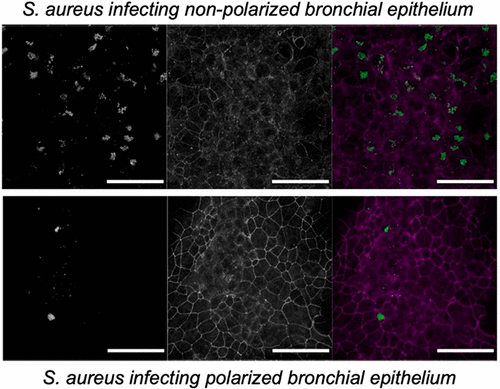当前位置:
X-MOL 学术
›
ACS Infect. Dis.
›
论文详情
Our official English website, www.x-mol.net, welcomes your
feedback! (Note: you will need to create a separate account there.)
Interaction of Staphylococcus aureus and Host Cells upon Infection of Bronchial Epithelium during Different Stages of Regeneration.
ACS Infectious Diseases ( IF 4.0 ) Pub Date : 2020-06-24 , DOI: 10.1021/acsinfecdis.0c00403 Laura M Palma Medina 1, 2 , Ann-Kristin Becker 3 , Stephan Michalik 1 , Kristin Surmann 1 , Petra Hildebrandt 1 , Manuela Gesell Salazar 1 , Solomon A Mekonnen 1, 2 , Lars Kaderali 3 , Uwe Völker 1 , Jan Maarten van Dijl 2
ACS Infectious Diseases ( IF 4.0 ) Pub Date : 2020-06-24 , DOI: 10.1021/acsinfecdis.0c00403 Laura M Palma Medina 1, 2 , Ann-Kristin Becker 3 , Stephan Michalik 1 , Kristin Surmann 1 , Petra Hildebrandt 1 , Manuela Gesell Salazar 1 , Solomon A Mekonnen 1, 2 , Lars Kaderali 3 , Uwe Völker 1 , Jan Maarten van Dijl 2
Affiliation

|
The primary barrier that protects our lungs against infection by pathogens is a tightly sealed layer of epithelial cells. When the integrity of this barrier is disrupted as a consequence of chronic pulmonary diseases or viral insults, bacterial pathogens will gain access to underlying tissues. A major pathogen that can take advantage of such conditions is Staphylococcus aureus, thereby causing severe pneumonia. In this study, we investigated how S. aureus responds to different conditions of the human epithelium, especially nonpolarization and fibrogenesis during regeneration using an in vitro infection model. The infective process was monitored by quantification of the epithelial cell and bacterial populations, fluorescence microscopy, and mass spectrometry. The results uncover differences in bacterial internalization and population dynamics that correlate with the outcome of infection. Protein profiling reveals that, irrespective of the polarization state of the epithelial cells, the invading bacteria mount similar responses to adapt to the intracellular milieu. Remarkably, a bacterial adaptation that was associated with the regeneration state of the epithelial cells concerned the early upregulation of proteins controlled by the redox-responsive regulator Rex when bacteria were confronted with a polarized cell layer. This is indicative of the modulation of the bacterial cytoplasmic redox state to maintain homeostasis early during infection even before internalization. Our present observations provide a deeper insight into how S. aureus can take advantage of a breached epithelial barrier and show that infected epithelial cells have limited ability to respond adequately to staphylococcal insults.
中文翻译:

在再生的不同阶段,支气管上皮感染后金黄色葡萄球菌与宿主细胞的相互作用。
保护我们的肺部免受病原体感染的主要障碍是上皮细胞的紧密密封层。当由于慢性肺部疾病或病毒侵害而破坏屏障的完整性时,细菌病原体将可以进入下面的组织。可以利用这种条件的主要病原体是金黄色葡萄球菌,从而引起严重的肺炎。在这项研究中,我们调查了金黄色葡萄球菌如何响应人类上皮的不同状况,特别是在体外使用再生过程中对非极化和纤维形成的反应感染模型。通过定量上皮细胞和细菌种群,荧光显微镜和质谱法监测感染过程。结果揭示了细菌内在化和种群动态的差异,这些差异与感染的结果相关。蛋白质谱分析表明,不管上皮细胞的极化状态如何,入侵的细菌都会发生类似的反应以适应细胞内环境。值得注意的是,与细菌上皮细胞的再生状态相关的细菌适应作用涉及到细菌面对极化细胞层时,由氧化还原反应调节因子Rex控制的蛋白质的早期上调。这表明在感染期间甚至内在化之前,细菌胞质氧化还原状态的调节就可以维持体内稳态。我们目前的观察提供了关于如何金黄色葡萄球菌可以利用突破的上皮屏障的优势,表明感染的上皮细胞对葡萄球菌感染的充分反应能力有限。
更新日期:2020-08-14
中文翻译:

在再生的不同阶段,支气管上皮感染后金黄色葡萄球菌与宿主细胞的相互作用。
保护我们的肺部免受病原体感染的主要障碍是上皮细胞的紧密密封层。当由于慢性肺部疾病或病毒侵害而破坏屏障的完整性时,细菌病原体将可以进入下面的组织。可以利用这种条件的主要病原体是金黄色葡萄球菌,从而引起严重的肺炎。在这项研究中,我们调查了金黄色葡萄球菌如何响应人类上皮的不同状况,特别是在体外使用再生过程中对非极化和纤维形成的反应感染模型。通过定量上皮细胞和细菌种群,荧光显微镜和质谱法监测感染过程。结果揭示了细菌内在化和种群动态的差异,这些差异与感染的结果相关。蛋白质谱分析表明,不管上皮细胞的极化状态如何,入侵的细菌都会发生类似的反应以适应细胞内环境。值得注意的是,与细菌上皮细胞的再生状态相关的细菌适应作用涉及到细菌面对极化细胞层时,由氧化还原反应调节因子Rex控制的蛋白质的早期上调。这表明在感染期间甚至内在化之前,细菌胞质氧化还原状态的调节就可以维持体内稳态。我们目前的观察提供了关于如何金黄色葡萄球菌可以利用突破的上皮屏障的优势,表明感染的上皮细胞对葡萄球菌感染的充分反应能力有限。











































 京公网安备 11010802027423号
京公网安备 11010802027423号